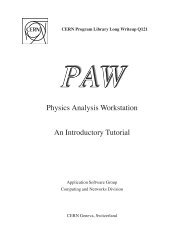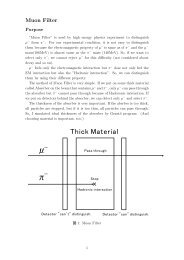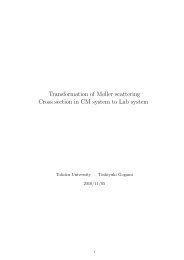The symmetrized Fermi function and its transforms
The symmetrized Fermi function and its transforms
The symmetrized Fermi function and its transforms
Create successful ePaper yourself
Turn your PDF publications into a flip-book with our unique Google optimized e-Paper software.
Symmetrized <strong>Fermi</strong> <strong>function</strong> 6529<br />
where N normalizes G(q = 0) = 1. We therefore wish to evaluate<br />
K =<br />
∫ ∞<br />
0<br />
cos(λx)ρ S (x, y) dx (22)<br />
where x = r/d, y = R/d <strong>and</strong> λ = qd. Since the integr<strong>and</strong> is even, we can write<br />
∫ ∞<br />
K = 1 2 R e iλx ρ S (x) dx. (23)<br />
−∞<br />
<strong>The</strong> integr<strong>and</strong> has poles at the complex points z =±y+iπ. Consider, therefore, the contour<br />
integral over a rectangle consisting of the real line z = x, the line z = x + 2iπ, <strong>and</strong> two<br />
ends which will be allowed to recede to ±∞. Using Cauchy’s theorem, we find<br />
(1 − e −2λπ )K = πi[e iλ(−y+iπ) −e iλ(y+iπ) ]. (24)<br />
Hence,<br />
π<br />
K = sin qR (25)<br />
sinh πqd<br />
where we have reverted to physical un<strong>its</strong>. By taking the derivative with respect to q we<br />
recover the result given in equation (3).<br />
Now we apply Blankenbecler’s method to the case of equation (20) to obtain the same<br />
result. Only even-order derivatives of H(y) = sin λy/λ are required, <strong>and</strong> one sees that<br />
D 2k H(y) = (−) k λ 2k H(y) (26)<br />
so that the operator D in equation (15) can be consistently replaced by iλ. This avoids<br />
having to sum a series that would otherwise converge only for |λ| < 1. We have<br />
K =<br />
iπλ<br />
sin iπλ H(y) = π<br />
sin qR (27)<br />
sinh πqd<br />
in agreement with the direct evaluation in equation (25).<br />
5. Other Bessel <strong>transforms</strong><br />
In considering models of quantum dots, we have had to deal with the problem of constructing<br />
the potential inside a semiconductor, knowing <strong>its</strong> form at the exposed surface. For cases of<br />
cylindrical symmetry the use of Fourier–Bessel expansions has some advantages over the<br />
more conventional Poisson formula. This lead us to consider the integral<br />
v(q) ≡<br />
∫ ∞<br />
0<br />
ρ S (r/d, R/d)J 0 (qr)r dr. (28)<br />
As before, we use dimensionless variables x = r/d, y = R/d <strong>and</strong> λ = qd. <strong>The</strong>n<br />
∫ ∞<br />
q 2 v(q) = λ 2 ρ S (x, y)J 0 (λx)x dx (29)<br />
0<br />
for which the <strong>function</strong> H(x) = λxJ 1 (λx). Note that this is an even <strong>function</strong> of x, so<br />
Blankenbecler’s method is no longer exact. In fact, the so-called small corrections are<br />
twice as large as for the usual <strong>Fermi</strong> <strong>function</strong>, which can be seen from equations (11) <strong>and</strong><br />
(12). But so long as they are negligible this has little importance (see appendix B for<br />
more discussion). Equation (29) can be evaluated by Blankenbecler’s method as above but<br />
requires a little more ingenuity. <strong>The</strong> result will be expressed using variables z = λy = qR,









